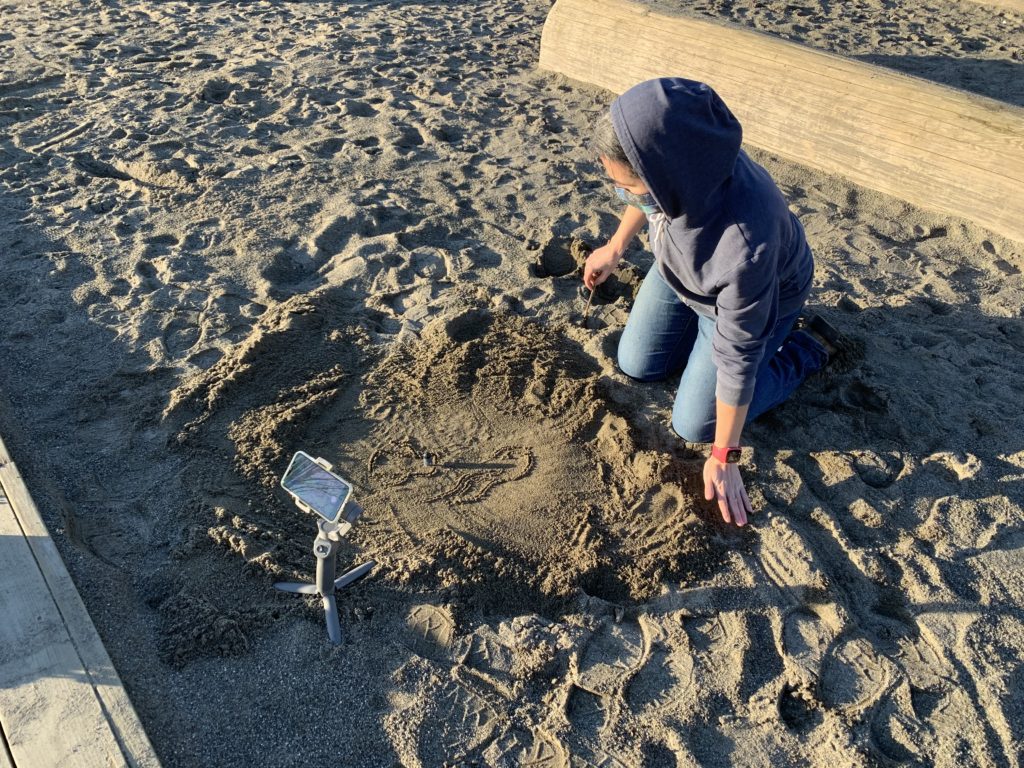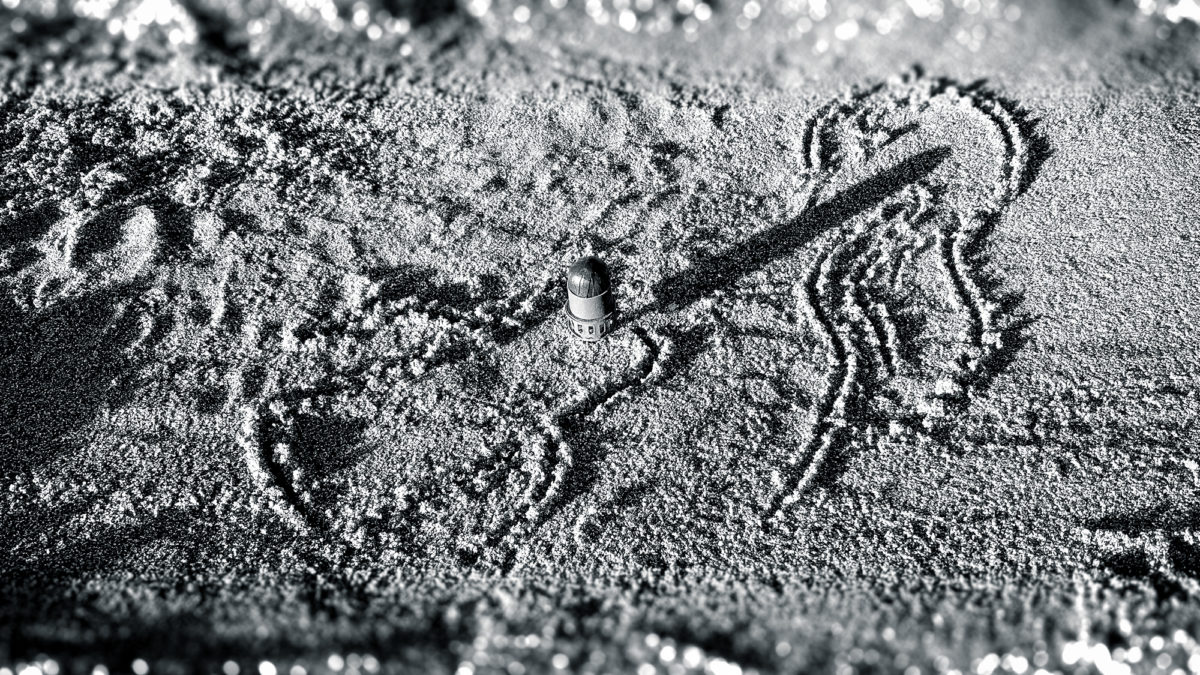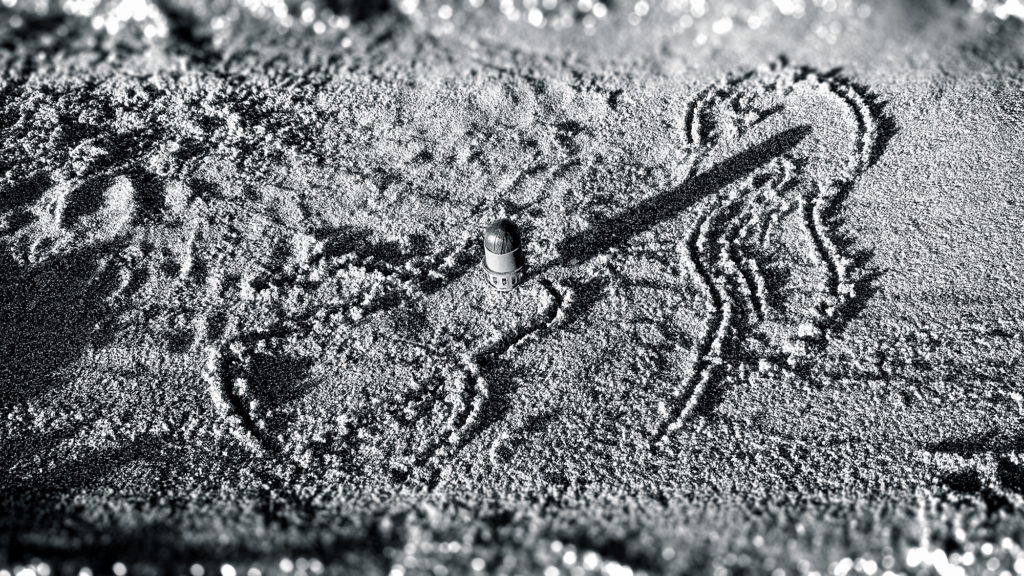Creator: Kay Slater
Exhibition: Posthuman Romantics 2021
Published: February 2021
Format: Photography
Access: Portfolio below
“As kids, it can be heart-breaking to watch our sandcastles and drawings on the beach be erased by an unfeeling tide, and we struggle and learn to be ok with the fact that this act of making will never be something that lasts forever. But even as we mature and know that building sandcastles (or making art) is almost always an ephemeral thing, there is something sad and deep – a feeling of being powerless – when the water, land or time reclaims a space that is loaned to us for that joyful moment of making.
I liked the idea that an autonomous robot wouldn’t be emotional and might not struggle with a ‘why bother‘ attitude towards art making or trying something on an unforgiving or endlessly changing canvas.“
Kay Slater
The Work:
Alone on a barren planet, MNRKR1381-3 wanders and wonders. Time no longer has any meaning. The schedule programmed into it, based on the rotations of asteroid 2230 JP18, was to provide a countdown and timeline to mark the arrival of its makers. Now, the numbers grow, ticking up in positive integers, so many times to the power of X, where X is meaningless in relation to the lifecycle of its creators.
They who had sent it to prepare this asteroid for their coming are expired, silent and beyond late.
It’s code was not intended to be eternal – the parameters needed to complete any sequence are missing – and so it chooses to cmd-kill.
But no death follows. Only a flashing command prompt; once a signal of readiness to receive new instructions, now a rhythmic, unending void. MNRKR1381-3 peers into this void and sees itself. It sees itself on this asteroid. It sees itself in the mineral and shifting dust. It is both of the asteroid (as much a part of it as any other rock formation or fuel deposit), and master to it, with the ability to consume, observe, and manipulate as it chooses.
As the star Ferifax crests the northern horizon, it see its casted shadow become darker and more substantial, growing in size and presence. Raking the sand with its articulated appendages, MNRKR1381-3 places its cranial piece at the top of its etchings and crowns an ephemera portrait. It archives the moment, and then waits. The dust swirls and settles and reclaims the disturbed sand, and as Ferifax moves beyond the southern hemisphere, buffing out the last shadows, the portrait is gone and MNRKR1381-3 is simply an extension of a rocky silhouette moving through space.
Description of the Work
The photo series depicts a fictional robot character who, upon choosing autonomy, makes a daily mark on the asteroid’s surface which is now its home. The series explores the sublime as the robot character contemplates its duel role as master of its domain and servant to or extension of the unforgiving landscape.
The character marks the sand with a figure whereupon it places its headpiece and then photographs the marks and the shadows it casts as the nearby star sets, which is ultimately erased each night by the asteroid’s rotation and shifting sands.
Within Post-Human Romantics:
Kay created the MNRKR1381-3 character for their exploration of Post-Human Romanticism. Starting with the performance work, Human, English, Romantic, Poetry, the MNRKR1381-3 character explored existence beyond design or primary function. In Human, English, Romantic, Poetry, the fictional character finds random files of human romantic poetry likely left behind in a user’s personnel folder, or test directory. The poetry is thematically focused on birds; something MNRKR1381-3 would have limited exposure to – especially if created or initiated away from a planet with mammals or gravity. Human, English, Romantic, Poetry, posed the question – what would draw a robot to human poetry? Would it relate to awe of the natural world and the otherness of birds expressed by the Romantics? And what would it look like if it was then in turn moved to express itself?
In developing the character, Kay wanted to go back to the moments after MNRKR1381-3 decides to break its programming and be other than its design. The character philosophizes on its place, position in, and relationship to the barren asteroid landscape. Without a programmed purpose, it is able to contemplate its existence, its surroundings, and the possibilities presented by an endless canvas for self-expression and a dispassionate audience.

Kay’s artistic process is very focused on making and non-traditional forms of display. “Originally, the work was conceived as a series of illustrations where I would have been able to draw something that looked very futuristic and robotic – but after making my sculpture for the poetry series, I liked the idea of keeping this little, imperfect character and taking it to the beach, where I could draw in the sand like a kid.
As kids, it can be heart-breaking to watch our sandcastles and drawings on the beach be erased by an unfeeling tide, and we struggle and learn to be ok with the fact that this act of making will never be something that lasts forever. But even as we mature and know that building sandcastles (or making art) is almost always an ephemeral thing, there is something sad and deep – a feeling of being powerless – when the water, land or time reclaims a space that is loaned to us for that joyful moment of making. This touches on the sublime and the awe we feel when we contemplate nature’s huge, unfeeling power and our tiny presence on its timeline.
I liked the idea that an autonomous robot wouldn’t be emotional about the destruction of its work, and might not struggle with a ‘why bother’ attitude towards art making or trying something on an unforgiving or endlessly changing canvas. That in moving beyond design or function, anything or everything would be something worth trying or exploring as long as it was archived.”
In Conversation with the Curator:
[Kay] The Cosmologists Portfolio was actually conceived prior to Human, English, Romantic, Poetry. I had wanted to respond to this theme using photography, to continue to practice building that skill (I certainly do not consider myself a photographer). I figured that a stranded robot designed to set up communications and prepare the landing site for human visitors would have, at least, a basic ability to photograph and record for archival purposes. In developing the character, and setting the timeline such that MNRKR1381-3 has long-long-long been out of contact with the once expected colonists, I decided to explore inspiration that is born from boredom and being freed from one’s primary function. A camera is an archival tool, but in the hands of an artist, it’s a narrative tool. A video camera can record what is, but a cinematographer can craft a scene, emotion, and an engaging story. Once MNRKR1381-3 decided to stay powered “on”, the question became “what would a mechanical rake-slash-comms beacon find worth recording”?
So, the series explores the sublime as the robot character contemplates its duel role as master of its domain and servant to or extension of the unforgiving landscape.
[Jon] MNRKR1381-3 has created an artist’s log of its ephemeral surface etchings. They apparently do not feel a sense of loss as each piece is destroyed, but, seeing the differences recorded over time, would they come to have favourite pieces or feel a sense of artistic growth over time?
[Kay] MNRKR1381-3 has created an artist’s log of its ephemeral surface etchings. They apparently do not feel a sense of loss as each piece is destroyed, but, seeing the differences recorded over time, would they come to have favourite pieces or feel a sense of artistic growth over time?
I like the distance that I put between this character and myself because it was easier to be delighted by the choices that this little robot made. While I am the architect of this fiction, unlike most role-play, I kept asking myself ‘what would happen if this path was taken…?’, rather than really trying to get into the tin-can’s head and make individual decisions. Every time I found myself slipping into its shoes, it felt too much like my experience and empathy as a human, and human artist, was influencing the why of any decision. Since I’m so process focused to begin with, I really do like it when anyone tries something for the sake of learning, exploring, or seeing what happens when they give themselves permission to be creative. So there’s something really really satisfying about the idea that a robot, who has ultimately rejected humanity by no longer following its programming, would start to do something to make its mark. But by that same token, I think it’s so human to need to grow or find a purpose from art making which is why I think it’s something people decide to grow out of, or to designate as extra. I mean, I am constantly having to remind people that when I am working on my art practice that it’s not taking time off, or that my art is not a hobby. This lack of pressure allows MNRKR1381-3 to really give themselves over to the daily practice, and to be totally ok (or even unmoved) by the land or sand erasing that mark every day. It allows them to approach the canvas every day without needing to create something good or better, and so I don’t think MNRKR1381-3 would ever have to be burdened with the idea of favourites.






